(Written by William)
When I first heard that LEGO Ideas was coming out with a tree house, I thought it would be a quaint little design great for putting next to any house. I didn’t pay attention to the LEGO Ideas submission that the set was based on, so I didn’t realize until the price was revealed that this tree house was much larger than I anticipated. After building the set, I have much more appreciation for the design. The sheer size of the tree is breathtaking, not to speak of all the remarkable details, and the clever parts usage. Plus, there is the delightful feature of being able to choose summer or autumn leaves for your tree!
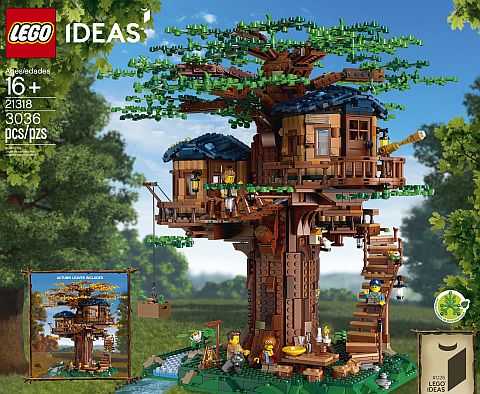
I have built a good deal of landscaping and nature models over the years, but the #21318 LEGO Ideas Tree House puts all of them to shame. It’s also interesting to note that the finished set is remarkably sturdy and one of the easiest large LEGO models to transport; you just grab the tree trunk, pick up the entire set, and put it anywhere you please. Nothing moves or falls off, which is remarkable given the amount of intricate details. Speaking of details, the set is full of excellent building techniques we can learn from. In this Brick Breakdown, we will focus on various nature building techniques, as I feel that this set sets a new standard for that style of building. So grab your hiking boots, a walking stick, and a good hat ‘cause we’re going green!
LEGO IDEAS TREE HOUSE – CLEAR-COATING TECHNIQUE
There are many ways to get interesting color effects when building with transparent LEGO pieces. We usually see some of the best examples of this when recreating water in a LEGO model. In the #21318 LEGO Ideas Tree House, we see some of these techniques in the small stream that runs across the landscape.
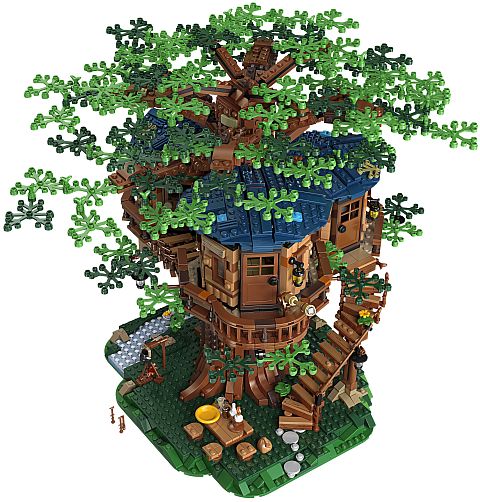
The technique itself is remarkably simple; start by taking a base color then add clear plates on top of it. What this produces is a three-dimensional gradient. The clear pieces will take on a bit of color from whatever is underneath them, which results in the clear top gradually shifting into the solid color underneath, and thus adding depth. However, clear-coating is more than just using clear pieces. LEGO has a wide array of various tints that have a transparent aspect. This means that the ability to mix and match colors as well as explore deeper levels is vast.

When using this technique, you have two things to consider. First, how much space do you have available? In this model, there’s only room for a couple plates of thickness. This means that LEGO designers couldn’t get too elaborate with the technique, and only used one layer of blue and one layer of clear pieces. The second consideration is about how light illuminates the clear-coat. If lit from underneath, you can really cut loose with the experimentation. Lit from the side can also be great for things not terribly wide, but equally complex. Lit from above, that’s where you start seeing diminishing returns. Even the clearest pieces will absorb some light. Each layer down sees less of the light spectrum. This is the other reason the #21318 LEGO Ideas Tree House only has a single layer of clear pieces. Without an additional light source, adding more layers would have lessened the effect.
As this technique involves filtering light, it might be a good idea to hunt out a professional take on how all of that works. My recommendation is to seek out tips on theatrical lighting. Live theater productions commonly use filters on their lights to create a great variety of moods, effects, and methods to focus your attention.
LEGO IDEAS TREE HOUSE – ANGLED SEAMS TECHNIQUE
One of the most impressive parts of the #21318 LEGO Ideas Tree House to me is how LEGO designers went about creating a seamless trunk. Between the roundness of the trunk and uneven bark, it could be a nightmare to create something natural looking. Yet LEGO designers were able to achieve that, and, I must admit, the tree looks very pretty even before the cabins are added.
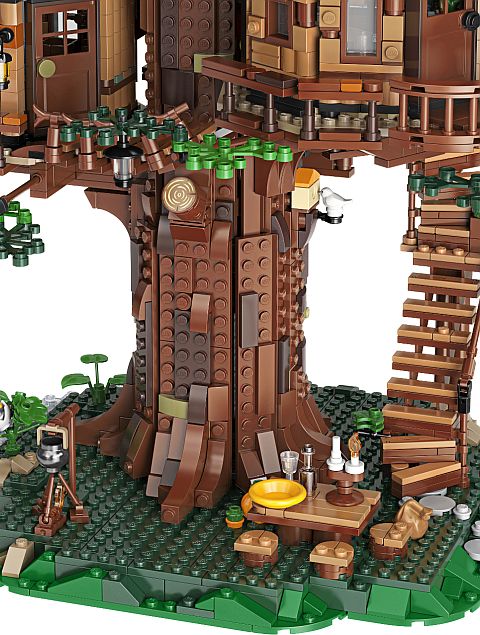
The secret to the tree trunk comes from a LEGO piece that has been around for a few years now, but it seems like each time it’s used in bulk, it has an interesting new usage. The piece I’m speaking of is the round 1×1 plates with a short bar off to one side. It’s small enough for detail work, but designed in such a way that it can also be a reliable workhorse for intricate building techniques. In the #21318 LEGO Ideas Tree House, it is used for building those elegant angled seams.
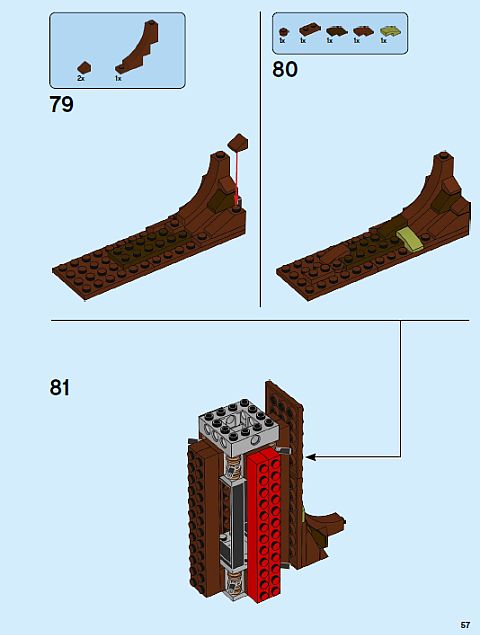
Inside the core of the trunk, a number of these pieces are used in the corners of the support structure. The roundedness of the piece allows the attached bar to be turned without running into the straight sides of the bricks surrounding it. This leaves a decent amount of bars to mount paneling to at various angles. Options for mounting to the bars include clips, hollow studs, axle holes, the insides of LEGO Technic pins, and a variety of specialty pieces. In the #21318 LEGO Ideas Tree House, we see axle holes used for the lower sections and hollow studs for the mid-section of the trunk.
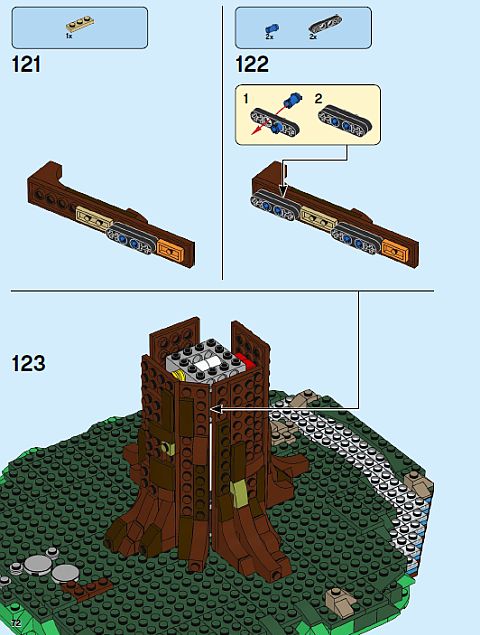
In the instructions, LEGO has you add the connectors in place after the larger middle panels. However, I would advise that if you are designing with this technique in mind that you do it the other way around. A lot of measuring is involved in getting the seams to line up. It’s often easier to create the angle you want then build out to it to make sure everything aligns the way you like.
I’d also like to point out that the same plate and bar piece can create interesting angled seams that involve rotating. To do this, connect the bar to a secure mount like an axle hole, then rotate the plate to the desired angle, and attach your panel to the rounded plate. It’s definitely a piece worth having in bulk in your collection.
LEGO IDEAS TREE HOUSE – NATURAL LOOK TECHNIQUES
There’s no doubt about it, this set out-classes anything I’ve ever built from LEGO when it comes to a realistic portrayal of nature. In past articles, we briefly touched upon how asymmetry can be used to add a bit of randomness to your model for a natural look. The #21318 LEGO Ideas Tree House uses the technique to a ridiculous level, but it also does so much more. So let’s treat this set as a master class in building nature.
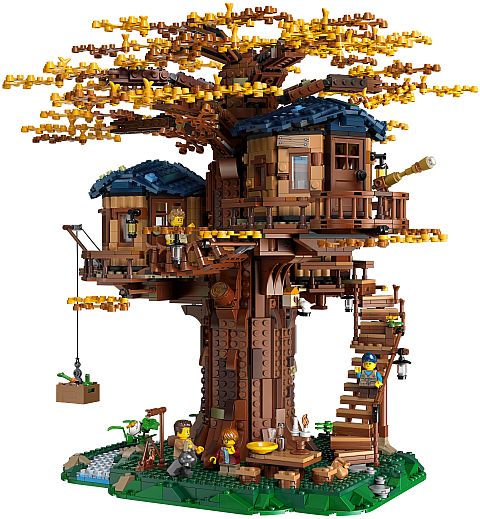
First, let’s talk variety. Nature does not typically organize itself in nice neat patterns. Therefore, anytime you can add variety into a creation, it can boost its natural profile. This set has quite a bit of similar elements when it comes to the core structure. For instance, the trunk has clear patterns in how each side connects to the center. In order to break this up, limbs are angled in different directions. Additionally, each limb that is similar, the largest ones are placed at different heights. Even the base of the model breaks up its uniformity by having a stream run through one edge.
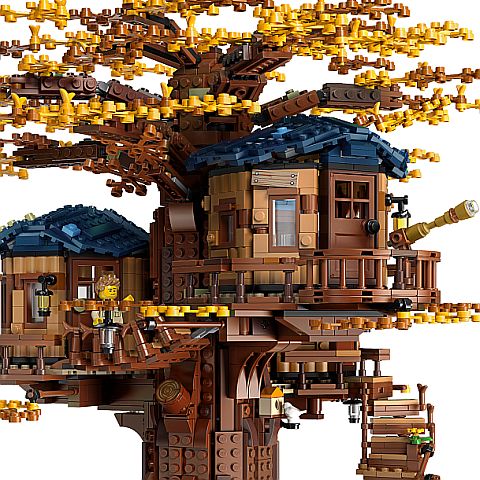
Another form of variety comes in the amount of texture that is used in the set. An odd slope, a random tile, and even pieces that are similar but in a different shape are all utilized to create a nearly unpredictable surface. Whether it is on the trunk of the tree, the walls of the little huts, or the limbs of the branches, each presents a subtly different appearance. This translates in our minds as something naturally grown rather than artificially created.
Next up for variety is the use of color. Mixing and matching like colors together creates a very mottled appearance. As you know, one of the biggest factors that changes nature is time. Time will erode and alter different aspects of nature. The end result is that colors vary widely in nearly everything found in nature. Scars from high winds or forest fires will leave marks just as much as heavy rains and rich soil. You know you’ve done it right when people don’t even comment on an odd color that stands out.

Finally, a great way to create a natural look is to avoid adding sharp corners. Do whatever you can to soften and round any structure. A sharp corner tells our brain that it has been crafted or made that way, so when there are very few obvious sharp corners, that impression/thought doesn’t come to the surface. It was a stroke of genius to have rounded cabins up in the tree, as well as making the stairs curve in two directions. It’s the perfect method to indicate harmony with nature.
LEGO IDEAS TREE HOUSE – FLEXIBLE PATH TECHNIQUE
The #21318 LEGO Ideas Tree House is getting a lot of praise. The detail work is both novel and intricate. But what I was most surprised by was the flexible bridge between the bathroom cabin and the kids’ room cabin. The bridge had two major obstacles to overcome; it needed to be able to flex up and down as it is connected to two cabins at different heights, and it also needed to bend horizontally to accommodate the curvature of the trunk. In addition, it needed to do all of this while keeping the planks relatively parallel to the ground. So how was this achieved? Simple, LEGO designers just used two sets of solutions.
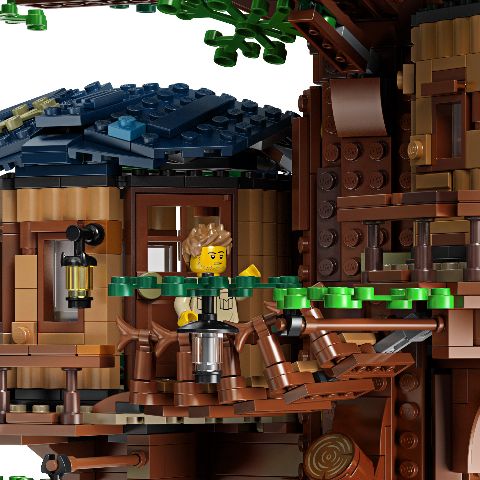
First, the vertical flexibility was done by using clips and bars. By putting them all horizontal, it meant they could only flex vertically, which is what was needed. Next, the ability to swivel was added to bend around the trunk. The solution for this was to place plates with rounded edges into the connectors. In this case, each bar piece has a rounded plate section. This simple feature allows pivoting the part without running into any square edge.
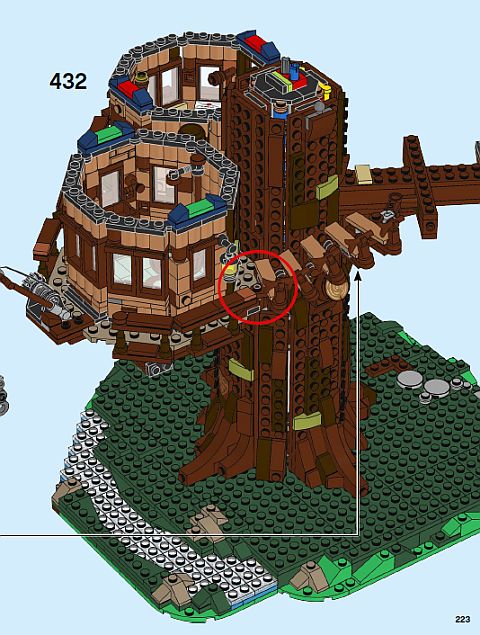
And as I mentioned, there was that third issue of connecting the ends of the bridge in such a way as to keep the planks level. One end had to be a ball-joint to make sure the odd angle the path is connecting in at can be accommodated. Therefore, the other end needed to be locked in at the horizontal to force every other plank to fall into line. For that, there is a 1×2 rounded plate. The plate portion is solid enough to prevent twisting, and the rounded edges make it ideal for the swiveling that needs to happen. The end result is something that is very understated in terms of looks, but a genius design on a technical level. It is important to note that this is used as a path here, but it is something that can easily be scaled to handle other building issues you may have.
APPLYING WHAT YOU LEARN
I love creating water effects out of LEGO parts! And so it’s so refreshing when we have an example of something easy to create that still looks amazing. Clear-coating does not tax your creative brain, but it is also hard to deny its effectiveness. Just keep in mind that water can also be frozen and you may have other ways to apply clear-coating.
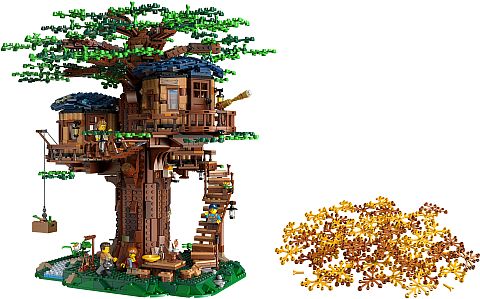
When it comes to covering up edges and seams, it can be hard to find a perfect solution. However, I must admit I’m hard pressed to think of a better way than what we see demonstrated in this set. I won’t call it perfect as it can be hard to attach, but it does look great.
Speaking of great looks, LEGO fans often don’t build nature very well. LEGO elements by their very nature are designed to make very obvious structures. In other words, it’s much easier to make something look man-made from LEGO elements. However, if you incorporate just some of the techniques used in this set, you can greatly expand your building skills.
Which leads us to the flexible path. As a creation, it teaches us good building discipline. If you have a host of issues to overcome, sometimes the best answer is to address them one at a time. The flexible path is not remarkable for how it looks in the grand scheme of things. Rather, it takes a systematic approach to resolve an odd situation. This is a great way to handle any building challenge you come across. If the problem seems too big, then step back and ask yourself, “How can I solve just one aspect of this problem?” Then you can build from there.
In the video above, I include some additional thoughts I have on the set. It’s my hope that as many people as possible can get their hands on the #21318 LEGO Ideas Tree House. I truly believe that this is one set that everyone would enjoy, and you’d regret missing out on. It is available at the LEGO Ideas section of the Online LEGO Shop.
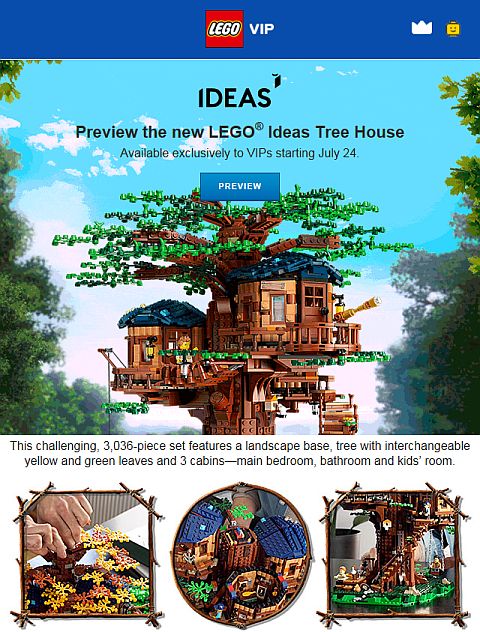
What do you think? How do you like the LEGO Ideas Tree House? Do you have it already? What did you think of the building techniques we discussed here? Are there any other techniques that you really liked while building it? Feel free to share your thoughts and discuss in the comment section below!
And you might also like to check out the following related posts:












This ideas set made feel very proud to be a Lego collector. The build was so unique in its building process. From building the trunk of the tree to the limbs and everything else. It’s was a great experience. I took my time building the tree house , because I wanted to appreciate the build and I did. Now the ideas tree house has become first place and the second place would be the old fishing shop. ( at least in my book).
I love those sets too. Come to think of it, they probably would look good next to each other.
This is one of the most beautiful sets they ever made. The more I look at it the more I like it. The shape, the colors, the little huts, the tree trunk and branches, the little creek are all so pretty. We need more sets like this!
The layered water technique has been used by afols for many years. I think the first time I have seen it in a Lego set is Ninjago City. The technique is most effective in my opinion when it’s two layers, but the bottom layer has some variation. So, for example, the bottom layer would go from dark blue to blue to light blue to represent water at different debts, and they cover the all with clear plates to make it more watery. Anyway, it’s a great technique and worth giving it a try.
Thanks for explaining some of the techniques. I usually don’t have the patience to analyze techniques, but there is always so much to learn. My favorite techniques in this set are how they did the trunk, and how sturdily the branches and leaves are locked in. As William said, this tree is solid!
I like your explanation on the bridge. There is so much going on there, it’s hard to analyze it all. It has a surprisingly sturdy construction, and as you said, it is able to solve several problems at once. You made a good pointer that sometimes it’s best to solve each problem separately.
Everything about this set is so beautiful! They did a very good job with the colors and the organic shapes. If someone is so inclined, it could even be converted into a home for elves, Robin Hood and his merry men, or even Ewoks.
Like others said, I don’t have the patience to study the techniques while I build a set (especially an awesome one like this), so I really appreciate the writeup. What I admire the most about this set is its natural beauty. I especially like how the manmade features wind up around the tree like a spiral staircase – first the steps, then the cabins – all the way to the top. The play features are nice too and not too over the top, so both kids and grownups can enjoy the set. I agree with the commenter above me that this could be a perfect treehouse for all types of inhabitants from minifigs to Ewoks.
I just started building this and I am amazed. The attention to detail is great. I’m really enjoying the way everything is coming together in such clever ways. Having a lot of fun with this build and I actually have a spot for it in my modest little Lego town.
Yeah, it’s a really sweet build! I have seen a number of people placing it into their city as a central attraction. 🙂